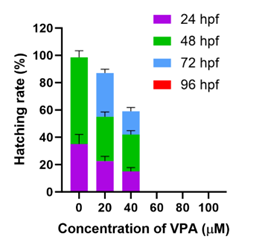Valproic Acid Induces Zebrafish Embryonic Developmental Defects by Inducing Oxidative Stress-mediated Apoptosis: Dose and Time-dependent Analysis
DOI:
https://doi.org/10.5530/ctbp.2025.1.1Keywords:
Valproic acid, Zebrafish, Developmental toxicity, Reactive Oxygen Species, ApoptosisAbstract
The study aimed to reveal the developmental deformities of the anticonvulsant drug valproic acid (VPA) in zebrafish embryos. The zebrafish embryos were exposed to VPA (up to 100 μM) after 4 hours post-fertilization (hpf) and examined for in-vivo toxicity by hatching rate, survival rate, heart rate, oxidative stress, and apoptosis. The VPA has dose and time-dependently affected embryos’ hatching, survival, and heart rate. The VPA delayed hatching and noticed unusual hatching at 72 hpf. Complete death of embryos was noticed at doses of 40, 60, 80, and 100 μM VPA at 72 and 96 hpf. Furthermore, VPA has negatively affected the heart rate and was found to be depleted with the dose and time of exposure to VPA. The VPA has induced various developmental defects in embryos, including yolk sac edema, pericardial edema, spinal cord curvature, and tail deformities. DCFH-DA staining revealed that the VPA escalated ROS molecules and induced oxidative stress in embryos. Acridine orange (AO) staining revealed that VPA causes toxicity in embryos by apoptosis. Overall, the study concluded that VPA induces developmental defects in zebrafish embryos by oxidativestress- mediated apoptosis in dose and timedependent ways. Thus, our study suggests that VPA release into aquatic ecosystems needs to be limited.



